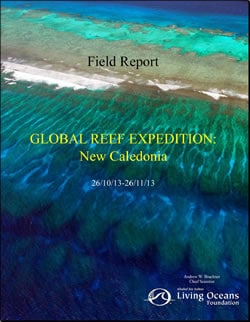New Caledonia Field Report
(2013)
Please find an excerpt of the full PDF below
Between, 26 October, 2013 – 26 November, 2013, the Khaled bin Sultan Living Oceans Foundation conducted a research mission to New Caledonia as part of the Global Reef Expedition. The research focused on coral reefs in four locations, Ile des Pins, Prony Bay, Cook Reef and the atolls of Guilbert, Huon, Merite, Neulka, Pelotas, Portail and Surprise. This is the field report resulting from that mission.
New Caledonia Field Report
 Khaled bin Sultan Living Oceans Foundation
Khaled bin Sultan Living Oceans Foundation
November 2013
By Andrew W. Bruckner
The project was conducted in partnership with the Institut de Recherche pour le Développement (I.R.D.), with involvement of scientists from Nova Southeastern University, University of the Azores, University of the Philippines, NOAA/University of Miami, Atlantic and Gulf Rapid Reef Assessment Program (AGRRA), Florida Museum of Natural History (FMNH), and the National Museum of Marine Biology and Aquarium (Taiwan). The objectives of the mission were to:
- Identify and characterize shallow marine habitats and develop habitat and bathymetric maps;
- Evaluate the composition, structure and health of coral reefs using a standardized assessment protocol;
- Assess the diversity, abundance and population structure of fishes, corals and other invertebrates, and algae, including commercially valuable species;
- Evaluate the effects of environmental stressors on coral health and subcellular changes through biomarker expression;
- Assess the prevalence and impacts of diseases and potential causative agents through histology.
- Measure ocean chemistry (pH) and effects on coral growth;
- Characterize the types of symbionts in reef building corals and variations in their photosynthetic efficiency under different environmental conditions;
- Characterize the diversity, evolutionary relationships between populations, and effects of the environment on green algae (the group Bryopsidales; Caulerpa, Halimeda and Codium) and the gelatinous red algae (Halymeniales) in Ile de Pins (I.R.D.);
- Examine the genetic diversity of giant clams (I.R.D.);
- Characterize and catalogue the taxonomy, biogeography, and systematics of invertebrates found in shallow marine environments (I.R.D. and F.M.N.H.);
- Investigate the extent of auto- and heterotrophy in different New Caledonian coral species exposed to various environmental conditions and determine the potential food sources for these species across varying scales of human impacts (I.R.D.);
- Evaluate the population status of commercially important sea cucumbers (I.R.D.); and
- Identify and characterize coral reef habitats of Prony Bay (I.R.D.).
Groundtruthing: A total of 2662 sq. km of WorldView 2 satellite imagery was acquired. To characterize shallow marine habitats, 593 videos (drop cameras) and 2,982,073 depth soundings were taken across study areas, covering a distance of 492 km…
